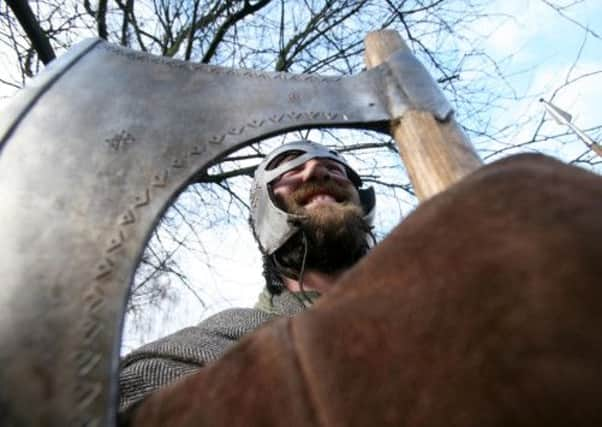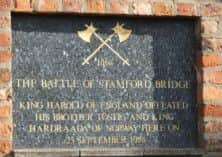Battle for Stamford Bridge to be given its due


No year is engrained more deeply on the soul of an Englishman than 1066. It was then, of course, that the last Anglo-Saxon King of England, Harold, was defeated at the Battle of Hastings by William of Normandy. The victor became William the Conqueror and King. England began to change.
For a start, the Normans were builders. They more or less invented the castle as we know it and over the next four decades built up to 1,000, including starting the Tower of London. Many of our solid stone churches and cathedrals, Durham Cathedral amongst them, took shape too. Everyday life evolved. Wine took over from ‘Old English’ mead as the drink of choice, apples were cultivated, thousands of French words entered the language and the Domesday Book famously provided the first written record of England.
Advertisement
Hide AdAdvertisement
Hide AdBut it could all have been very different. Harold’s downfall may have been an unfortunate consequence of another battle he engaged in just before Hastings. Fought on Yorkshire soil against Viking invaders, this was the Battle of Stamford Bridge.


Harold won this encounter but it left his army depleted, weary and ill prepared for the Battle of Hastings at the other end of the country only three weeks later. The English were unable to repulse the Normans and Harold himself was killed. The rest, it hardly needs saying, is history.
Some believe that although the Battle of Stamford Bridge was an English victory, the Battle of Hastings was effectively lost there rather than on the south coast.
Amongst them is Tom Wyles, Secretary and a founder member of the Battle of Stamford Bridge Society. He argues that Stamford Bridge’s contribution to this momentous few months of our history has been overlooked, prehaps even air-brushed out.
Advertisement
Hide AdAdvertisement
Hide Ad“Ask most people about Stamford Bridge and they will think of Chelsea Football Club,” he says. “The significance of the Battle of Stamford Bridge has been forgotten. If Harold’s army hadn’t had to come north and then march straight back again leaving them weakened, what would have happened at Hastings?”
You can’t help thinking that Harold blundered into a tactical error by trying to fight on two fronts almost simultaneously but to understand his predicament, we must turn the clock back to the fraught environment that was 1066. Edward the Confessor, King of England, had died leaving no obvious heir and although Harold Godwinson was quickly crowned, there were other powerful names vying for the throne.
One was Harald Hardrada, Viking King of Norway; another was William of Normandy. Harold expected both to invade, but didn’t know when.
In the event, Hardrada landed first, in Yorkshire. Joining with him was Harold’s estranged brother, Earl Tostig. After the Battle of Fulford outside York, the Vikings gained control of the city. Harold decided to confront them, covering the 200 miles from London in four days.
Advertisement
Hide AdAdvertisement
Hide AdAfter he had defeated the Vikings and while he was still at York, Harold received the news he must have been dreading. William had landed unopposed on the south coast. The English had no option but to turn about and head 250 miles back down the country to challenge the invaders.
Academics too ponder what might have been. Dr Sethina Watson is a mediaeval historian in the Department of History at the University of York. She says: “Had the English army been there in the South when William landed, had it been fresher, the odds would have been much more favourable for Harold.”
Tom Wyles refers to the Battle of Hastings as “that little battle down south”. Having lived in Stamford Bridge for 23 years, he is keen to raise the profile of the battle that took place there. Since 2010 he has quite literally been bringing it to life, organising battle re-enactments to mark what happened on September 25, 1066. This year’s re-enactment takes place this coming weekend. It is set to be bigger than ever, with a full village of Viking tents, demonstrations of crafts and weapons, history and tales recounted by skalds (storytellers) and, of course, the battle itself with full costume and weaponry.
Giving an additional touch of authenticity, the Viking force is being led by Icelander Jarl Gunnar Olafsson, said to be a direct descendant of King Hardrada.
Advertisement
Hide AdAdvertisement
Hide Ad“In amongst the warriors when they’re fighting, it’s for real,” says Tom. “You can almost taste the adrenalin. People get hyped up – you could swear you were part of a real battle.”
The ‘original’ Battle of Stamford Bridge was fought mainly with axes, throwing spears, arrows, swords and the most feared weapon of all, the Dane axe, decribed by Tom as “the Exocet of the day”.
The re-enactment sounds a foolproof way of gaining attention for what happened at this Yorkshire village almost 1,000 years ago but members of the Battle of Stamford Bridge Society have even more ambitious ideas up their chain-mail sleeves.
At the moment there is a modest monument to the battle in the village but they would like to see a visitor centre, a reconstruction of a Viking longhouse and battlefield walks with information boards.
Advertisement
Hide AdAdvertisement
Hide AdToday there is little public access to Battle Flats, the fields to the south-east of the village where the fighting is thought to have taken place. It’s another indication of the battle’s low profile. And although the area has been designated as a registered battlefield by English Heritage, it has not been safe from modern development.
The Battlefields Trust points out that as Stamford Bridge has expanded in recent decades, new houses have been built actually on the battlefield. Julian Humphrys, Development Officer, says the problem is that even a registered battlefield doesn’t receive full statutory protection – it only means the historical importance ‘must be considered’ at the planning stage.
“All English battlefields are vulnerable to development,” he says. “We wouldn’t want to see a housing estate on any registered battlefield, nor a ring road or anything else. It’s not so much that houses shouldn’t be built but once a battlefield has gone, it has gone for good.”
The battlefield at Stamford Bridge is not just of note because of the role it may have played in the Norman Conquest.
Advertisement
Hide AdAdvertisement
Hide Ad“The battle also ended the Viking era,” explains Dr Sethina Watson. “This was the last of the great Viking incursions.”
Tom Wyles puts it more bluntly. “The Vikings, originally numbering perhaps 15,000, arrived in 300 ships. They left in just 30.”
All that considered, how is it that what happened at Stamford Bridge has become so little known now? Tom provides an answer.
“When a victory is secured in battle, the winners write the history. Harold won Stamford Bridge but three weeks later he was dead. The history we know today was written by William.”
Advertisement
Hide AdAdvertisement
Hide AdDr Watson agrees. “Had William of Normandy not invaded, Stamford Bridge would have been remembered as a great battle. But it got pipped.”
It’s an odd twist that the Battle of Stamford Bridge should have turned into a modern battle for recognition but Tom Wyles senses victory. In 2016 it will be the 950th anniversary and by then he hopes the annual commemoration will have grown to attract thousands.
“This re-enactment is set to go massive,” he says. “Bigger than the one they have at Hastings.” Some might say nothing could be more fitting.
Fighting for a place in history: 1066 and all that...
The conflicts of 1066
Battle of Fulford: September 20, 1066
Battle of Stamford Bridge: September 25
Battle of Hastings: October 14
The key figures
Harold Godwinson, Anglo-Saxon King Harold II of England January to October 1066. Killed at the Battle of Hastings.
Advertisement
Hide AdAdvertisement
Hide AdHarald Hardrada, Viking King of Norway. Killed at the Battle of Stamford Bridge.
Earl Tostig, Harold’s estranged brother. Killed at the Battle of Stamford Bridge.
William, Duke of Normandy (William the Conqueror), King William I of England 1066-87.
The battles marked the end of Anglo-Saxon England and the Viking era and the beginning of the time of the Normans.
Advertisement
Hide AdAdvertisement
Hide AdThe Battle of Stamford Bridge Society Re-enactment Weekend takes place tomorrow and Sunday at Stamford Bridge Cricket Club. www.thebattleofstamfordbridge.blogspot.co.uk
To find out more about the battle, read 1066: The Battle of Stamford Bridge by Chris Rock of the Battle of Stamford Bridge Society.